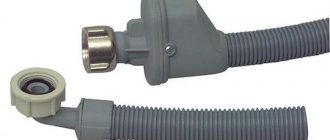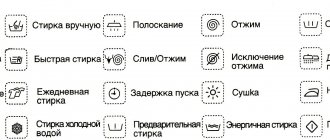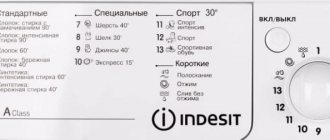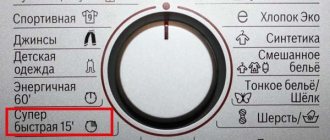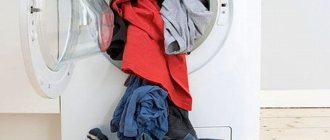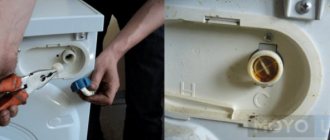The drum is often referred to as the "belly" of an automatic washing model. The drum of the washing machine accepts clothes for washing. Water with dissolved detergent goes into the tank. Through special holes it gets to the laundry. Stainless steel is used to create the drum. And the tank can be made from various materials.
Enameled coating
Not so long ago, manufacturers produced cars with enamel tanks. But such models did not work for long. If even a tiny crack appeared on the enamel coating, the metal underneath was subject to rust.
This option - enameled metal - has a number of features, positive and negative. Their details are given below:
Positive sides
- Reliable operation when placing any laundry.
- The enamel produces a protective layer. And it protects the metal from the effects of corrosion.
- What material can containers be made of that can be confidently called strong? This is a twofold question. During transportation, the likelihood of damage is very low. And with significant temperature changes they do not split.
Negative
- An impressive mass.
- The container is not shockproof.
- With very long use, chips form on the container. These are the consequences of impacts from foreign objects. In damaged areas, the enamel crumbles. The defensive layer disappears. Without it, the metal becomes rusty and destroyed. After a certain period, leaks are observed. And the owners must either replace such a tank or purchase new equipment.
It should be noted that containers from this variant are no longer produced. There have been too many accidents when using them. And to create tanks they began to use plastic or a stainless steel base. Which tank is the best of these options is a controversial question.
Metal
Enameled steel was previously used as metal for tanks. This material is not very suitable for washing machines. When carrying or during washing, the surface may chip. Rust appears in this place, and later there is a hole and a leak.
For this reason, such tanks are not currently produced. They are only found in old cars. If the tank in such a device leaks, practically nothing can be done. Alternatively, use a welding machine. But such a decision is very controversial. It's better to buy a new car.
Plastic version
Which drum will do? Each company has a special one. All types of plastic used have their own characteristics. For example, carboran is close to stainless steel in terms of qualities such as durability, strength, and reliability. But its properties are surpassed in terms of thermal insulation and vibration reduction.
The main polymer materials are: carborane, carbotek, carferon, silytek and polynox.
For all of them, the main substance is a special polypropylene. It contains calcium carbide. It significantly improves the strength of the material and its resistance to detergents. The fewer different added elements in the plastic, the worse the plastic tank.
Advantages of plastic
- Does not corrode.
- Good in terms of durability.
- Modest mass.
- Does not absorb water.
- Reduces noise during drum rotations.
- Saving electricity consumption.
- Resistance to aggressive chemical elements.
Which is better to choose? Despite the existing strengths, modifications with plastic options, when compared with steel versions, break more often and are not resistant to mechanical influence. But today the development of plastic composition does not stop. And each company adds its own “zest” to this material. In this way, these plastic components of the machine gradually develop their strength and reliability. And when solving the dilemma of how appropriate a plastic container is in this technique, the answer is more positive. It is also worth noting the low cost of this material. And modern manufacturers are motivated to reduce the cost of devices with plastic tanks.
Weaknesses of plastic versions
As has already been noted, many companies are trying in every possible way to modernize and strengthen the plastic for their cars. But for now, this washing machine tank material is susceptible to splitting and is quite fragile. This is his main and only weakness.
If the machine is poorly transported or someone forgets to remove special bolts before starting, the integrity of the container may suffer. And she will simply break; there cannot be any worse consequences. And the car will no longer be able to be used. You will need to replace the tank or even buy a new car.
If the plastic is of excellent quality and if handled with care, it can last 20-25 years.
Polynox
Polynox tank
One of the most popular materials, which includes polypropylene and calcium carbide. Has the same advantages as plastic. In addition to polynox, there are other similar substances. They differ slightly in composition and are called composite materials.
The varieties are as follows:
Depending on what the manufacturer added to the composition, the quality of the resulting substance will differ. For example, carborane is stronger than polynox. But since there are no significant differences, composite materials for tanks are considered together.
Products made from polynox can last until the end of the life of the washing machine. Each manufacturer is trying to develop more and more durable polymer options. Some of them already have the properties of both plastic and metal. Such parts do not break down for up to 30 years.
So, now the most popular materials for making washing machine tanks are stainless steel, plastic, polynox and its variations. The choice is determined by a person’s finances and living conditions. If you move frequently, there is a high probability of damaging the plastic tank. But it is lighter, cheaper and less noisy. And yet, experts do not recommend looking at the material first.
Power consumption, brand, and technical characteristics are considered more important. The easiest way is to select several cars with suitable functions, price and country of origin, and from them choose the best one with the required tank.
Steel-stainless steel option
Cars with a metal tank made from this material are considered classic. Since such steel has long been used to create these components of the washing machine.
Knowledge of the following specifics of a tank made of a given material helps to solve the dilemma with the best tank option for washing equipment:
- Superior durability.
- Impressive service life. It can reach 100 years.
- High resistance to water.
- Resistance to chemical aggressors. They can be contained in different detergents. Scale also poses such a threat.
Disadvantages (when compared with the plastic version):
- Inability to suppress vibration. As a result, strong noise is generated.
- An impressive mass.
- Lack of thermal insulation. This minus seriously increases the electricity costs for the operation of automatic washing models with containers made of the specified material.
- If a stainless steel tank is of solid quality, then its price tag is very serious. If you come across a device for sale with a steel container and a low price, do not rush to make a purchase. This device most likely has poor quality of tank material and welding. The nodes are poorly assembled.
Results
Still, what is the best material for a washing machine tank? When purchasing a washing machine, pay close attention to its technical parameters, and especially the level of resource consumption: water and electricity, functionality, and range of options.
And the material of the tank is one of the final criteria for choosing washing machines. Of course, the stainless steel version is stronger. But who is interested in a service life of 100 years these days?
The choice of an automatic machine is influenced not only by the number of functions, but also by the materials used to make components and parts. The material of the washing machine tank is an important criterion on which the service life of the equipment as a whole depends. What to give preference: stainless steel or plastic? Let's figure out what the manufacturer offers its buyer.
Stainless steel
The most expensive and durable material. It is assumed that a stainless steel tank can last at least 100 years. Of course, no one checked this, since no machine is capable of working that long.
Stainless steel tank
Stainless steel is valued for the following qualities:
The disadvantages include the machine being too noisy, its high price and high energy consumption. The hum occurs due to friction and knocking on the metal drum, as well as the low soundproofing properties of steel. The price of the machine is determined by the cost and durability of the material. Water in a metal container cools down faster, you have to heat it up more often, and as a result, more energy is wasted. Significant weight of a part is also considered a disadvantage, but not always.
I work in the household appliance repair industry. Extensive experience in restoring washing machines and dishwashers.
It should be remembered that stainless steel is an expensive material. With high-quality soldering, the price of the machine cannot be low. If a washing machine is offered at a very attractive price, it may turn out to be of poor quality and will not last long.
Stainless steel tanks are the most popular. However, finding them can be difficult. practices the use of stainless steel tanks. Many manufacturers most often use plastic or polynox to reduce the cost of their products.
Types of tanks in a washing machine
Many users confuse the concepts. So, on the forums you can find questions: what is better to choose - a steel or plastic drum? Is it worth overpaying for stainless steel products?
Firstly: the drum is the container in which the laundry is directly located during washing. You see it when you open the hatch door. The side and rear walls of the drum are equipped with holes for water. This container is made only from stainless steel, so you don't have to choose.
The teardrop drum (VarioSoft) is a Bosch technology. The teardrop-shaped protrusions on the walls are smooth on one side and steep on the other. When rotating in one direction, a strong impact is applied to the laundry; when rotating in the other direction, the contact is minimal and the touches are smooth.
Secondly: inside the tank there is a washing machine drum (WM). Water supply and drain pipes are connected to it. Liquid with detergent is poured through them, which then seeps into the holes of the drum. After finishing the wash, the used liquid is drained.
There are washing machines with a stainless steel, enameled, plastic and combined tank. Plastic refers to various composite materials that manufacturers have developed. Each company gave them their own names: polynox, carbotech, fibran.
Enameled steel . The basis of the product is ordinary steel. To protect against corrosion, the steel is coated with enamel. During operation, the unreliability of such tanks was proven. A small chip in the coating led to corrosion and the formation of a fistula. Therefore, manufacturers stopped producing enamel containers. But they can be found in older SM models.
Plastic . Washing machines with a plastic container are lightweight and quiet. The main advantages of plastic:
- Low thermal conductivity. The water heats up faster and stays warm longer, and you can save on electricity.
- Low noise level. During spinning and vibration, the tank comes into contact with the stainless steel drum, which can lead to loud operation. Whereas plastic dampens vibrations.
- Low price compared to other materials.
- Service life more than 10 years with proper use.
- Fragility. The plastic product may crack during transportation. There have been cases when an object stuck between the drum and the tank caused damage to the latter.
Important! Plastic should not be gray. This can be easily checked by bending the hatch cuff. Such material quickly dries out and becomes unusable.
Composite materials . These are polymers that include part of plastic and composite:
- Polyplex. It is resistant to temperature changes, corrosion, and chemicals. Ensures quiet operation of the device by absorbing vibrations. Just like plastic, it is susceptible to cracks.
- Carborane. An environmentally friendly composite that combines the advantages of stainless steel and plastic. It is not only resistant to high temperatures, but also has resistance to mechanical damage at the level of steel.
These include Carbotec and Silitec. They have no fundamental differences.
Stainless steel tank . The most reliable, durable and expensive material. Interestingly, with high-quality welding, such a product can last up to 100 years. It’s a pity that the service life of an automatic washing machine (WMA) does not exceed 10–15 years. In the future, the container will be useful to you for making homemade products. Disadvantages include noisy operation.
Some manufacturers (Ardo) compromised and made combination tanks - the rear main wall is made of stainless steel, and the side parts are made of composite. Sometimes the rear part can also be plastic, but the stiffening ribs are installed in steel. These tanks combine the pros and cons of both materials. They are distinguished by durability and long-term operation, but the cost of such devices is high.
Features and purpose
Many washing machine owners mistakenly assume that the tank and drum are the same part in household appliances. A drum is a container into which dirty things are placed. It is always made of stainless steel. Tank is a container for the drum. Liquids, powders, conditioners and other laundry detergents are poured into it.
All this enters the drum through special pipes.
Tanks are:
The former consist of two halves connected to each other using fasteners, while the latter are a one-piece, non-separable structure.
The tank is an important part in any washing machine. Water is poured into it (depending on the machine model, from 30 to 60 liters). To avoid strong vibration during washing, spinning and rinsing, the tank is not rigidly attached to the body. To soften vibrations, springs are located in the upper part, and a shock-absorbing system is located in the lower part. For these purposes, manufacturers also install concrete counterweights on containers.
The washing machine tank takes on a colossal load. Water is heated in it, chemically aggressive laundry detergents enter here, and it can withstand sudden temperature changes. Therefore, the quality and durability of this part will depend on the type of raw materials used in the production of tanks. Let's look at the most popular materials used by manufacturers.
Purpose and design of the tank
This is the main element of the washing machine. Often the breakdown of such equipment is associated with it. It happens that there is a foreign object in the tank that makes unpleasant sounds during rotation. It happens that such an object causes the drum to jam, or it causes cracks to appear in the tank.
The method of fixing the tank is similar in different machines. To create movable fastenings, shock-absorbing devices and springs are used.
To reduce vibration, counterweight elements in the form of weighted concrete blocks are used.
The laundry drum of the washing machine together with the tank constitute a kind of automatic “abdominal cavity”:
- the drum receives the laundry to be washed;
- The tank is filled with water containing detergents. Liquid gets onto the laundry through perforation holes.
The drum of a washing machine is always made of stainless metal material. Its side surfaces are perforated, and the same holes may be present on the back wall. And various materials can be used to make the tank itself.
Until recently, washing machines were made with an enameled steel tank. But the operating period of such a machine did not differ in length; with small cracks in the enamel coating, corrosion began to form.
Because of this, most manufacturers of household appliances abandoned such unreliable raw materials and began manufacturing tanks from plastic and stainless metal. Today, the material of the washing machine tank varies. Its strength and durability are the key to good operation of the machine, as it experiences significant loads and temperature changes.
What is better to choose
Washing machines with a stainless steel tank are considered the most reliable and durable. But in terms of price, such SMAs are significantly more expensive than analogues with a reservoir made of composite materials. The stainless steel tank weighs a lot and is quite noisy during operation.
Composite plastic analogues are lightweight, less noisy and inexpensive, which allows manufacturers to offer equipment at a more affordable price.
Advice! When using SMA with plastic tanks, you should be careful during transportation and carefully check the pockets of your items before putting them in the wash. Compliance with such measures will extend the life of an important component.
The quality of polymers is improving year after year through the use of new manufacturing technologies. Also, in some models, manufacturers practice installing combined tanks. From year to year, the electronic technologies used to equip the SMA are being modernized. In modern conditions, equipment with a plastic tank is an economically viable option, subject to careful operation.
What material is the tank made of?
Further in the article we will consider all known options.
Plastic
Each company has its own secrets and uses plastic raw materials with certain characteristics. For example, carborane is reminiscent of stainless steel material in its durability, strength and reliability. And the thermal insulation and vibration reduction properties are even superior to stainless steel.
The most commonly used polymers are carborane, carbotec, carferon, silitek, and polynox. They all have one common feature - the main component is considered to be a special polypropylene material containing calcium carbide. This additive significantly increases the strength of the plastic and makes it resistant to detergents used in washing. The quality of the tank itself changes depending on the amount of special additives in the plastic.
The main advantages of raw materials include:
- resistance to corrosion;
- high strength indicators;
- moderate weight;
- the material is not exposed to moisture;
- the noise level decreases during element rotation;
- electrical energy is saved;
- resistance to aggression of chemical compounds.
There are many positive qualities, but you should know that household products with plastic tanks fail more often and are of little use for mechanical impacts.
It would be fair to note that the development of plastic raw materials does not stand still, and each manufacturer adds its own “zest” to such raw materials, which allows improving strength and reliability. In addition, the raw materials are considered cheap, which affects the overall cost of the washing machine.
In addition to the positive characteristics, there are also negative aspects. It has already been noted that companies are trying in every way to improve plastic tanks. But the material still remains brittle and susceptible to splitting, which is its main weak point.
If transportation rules are violated or the bolts securing the drum are left behind, the container may be damaged. After this, the machine will no longer be able to be used. You will have to purchase a new unit or look for a similar replacement tank.
With good quality plastic raw materials and compliance with operating rules, the tank will last from twenty to twenty-five years.
Stainless steel
This high-quality metal is considered traditional and is very popular as a raw material for tanks. It will be enough to remember the old models of cars that are still found in garages and sheds. The unit has long since lost its functionality, but the stainless steel tank continues to maintain excellent external characteristics. And a long operational period is not considered the only advantage of such raw materials.
Manufacturing materials
Strong and durable material is the key to successful operation of the washing unit, because the work is constantly subject to serious loads and temperature changes. Foreign objects may damage or block system operation.
Manufacturers use the following types of material to make the drum container:
- stainless steel;
- plastic;
- polymer;
- metal.
Stainless steel
Steel copes better than others with constant interaction with water, and is also particularly durable. It is very often used as a material for the washing machine tank. The main advantages are:
- durability;
- reliability;
- strength;
- The tank, made of stainless steel, will serve you for many years.
Despite this popularity, there are also disadvantages:
- High noise level. This is caused by the inability to dampen vibration and noise. Many housewives are unhappy with this phenomenon.
- High price. A product made of high-quality steel with conscientiously welded seams cannot have a low price.
- Devices with metal drum containers consume more electricity, since metal has low thermal insulation.
Plastic
The second place in demand is occupied by products made of plastic and other polymers.
The advantages are:
- Low cost.
- They don't make noise. If you believe the advertising, things will be washed absolutely silently. They do an excellent job of absorbing noise and vibration.
- Less energy consumption due to good thermal insulation. Heating water requires less energy.
- Not susceptible to corrosion or chemicals.
- Light weight of the product and the device itself. When repairing, it is much easier to remove than a metal one.
- Relative strength. When compared with stainless steel products, plastic elements will lose out due to their fragility. However, constant developments are underway in this direction, and the composition of polymers for the manufacture of parts is improving, becoming stronger and more reliable. The service life can reach 30 years, which is significantly lower than that of stainless steel. However, this is enough, since the service life of the washing machine itself will come to an end after this time.
The only but significant disadvantage is:
- Fragility. Damage may occur during transportation or if foreign objects get between the drum and its reservoir. Breakdowns can be very serious, making it impossible to use the equipment.
Each washing machine manufacturer uses its own polymer composition technology.
Plastic differs in characteristics, has low cost and high fragility. Due to additional impurities, the strength of the composition increases, and in some cases, products made from polymers are not too inferior in reliability to stainless steel elements and perfectly withstand the aggressive effects of chemical detergents.
Composites
In order to offer household appliances at affordable prices, manufacturers began to use composite plastic materials for the manufacture of tanks: polynox, carbotech, fibran and others. The machine operates with such a tank with a low noise level. The low thermal conductivity of composites promotes rapid heating of water and heat retention, which is more economical in terms of energy costs. But compared to stainless steel, many composite polymer materials are fragile and require careful transportation and operation.
- Polynox is a composite of polypropylene and calcium carbide. A reservoir made of such plastic is light and durable, retains heat for a long time, absorbs vibrations, and is resistant to corrosion. The tank, subject to the manufacturer's recommendations, can last up to 30 years.
- Carbotech is a composite that is not inferior to stainless steel in terms of resistance to mechanical damage and has all the advantages inherent in plastic.
- Silitek, Karbotek, Carferon are similar materials with excellent performance characteristics.
Other qualities of the machine element
Before you buy a washing machine, you should find out how much laundry it can wash in one load. For a large family, it is recommended to purchase models with a load of at least six kilograms.
Often the surface of the tank is coated with a special composition that brings benefits by having a disinfecting effect on the water.
Plastic raw materials and stainless steel are popular today. Each of the materials is quite acceptable and has a long service life. Everything is clear with the advantages; for comparison, here are the negative points:
- a stainless steel tank makes more noise compared to its plastic counterpart;
- elements made from plastic raw materials are considered brittle and cannot withstand mechanical stress.
Note that plastic raw materials are gradually pushing stainless steel out of the production process. It is quite possible that such machines will soon cease to be produced. Which option is better is up to you to decide.
Pros and cons of plastic
The positive qualities of polymer parts include:
- Anti-corrosion qualities. Plastic does not rust under any conditions;
- Strength of parts. Thanks to special additives, modern polymer can withstand loads no worse than metal;
- Ease. Even those polymers that include additives are lighter than steel;
- Noise suppression. The lightness of the model helps to reduce noise during operation;
- Less electricity consumption. Due to better heat retention compared to stainless steel, polymers prevent water from cooling too quickly;
- Resistant to detergents. Polymers withstand the effects of washing powders, bleaches and liquid detergents;
- Lower cost. To produce plastic, there is no need to mine metal ore and process it into steel. Its production cycle is much simpler and shorter.
The plastic model may seem flimsy compared to a stainless steel tank. In fact, this is only an appearance.
Modern additives to polymers give them strength no less than that of metal and guarantee trouble-free service for 20-25 years.
However, they still have disadvantages. Plastic can break if transported incorrectly or too frequently.
Cellular novelty
The honeycomb-shaped drum is considered an unusual invention by Miele, patented so timely that you won’t find anything like it in washing machines from other companies. According to the manufacturer, this model reduces the cost of electrical energy and is more careful with things. The complete absence of welds extends the operational life of the element.
A distinctive feature is that the inner surface of the drum has hexagon-shaped holes, concave inward. During washing, a thin film is created between the laundry and the drum, protecting the material.
Advantages and disadvantages of stainless steel:
- Tolerates contact with water painlessly and does not rust;
- The parts are durable and can withstand several moves;
- Very long service life, about a hundred years;
- Immunity to the chemical composition of laundry detergents.
But don’t let the apparent perfection of stainless steel drums fool you. They also have their drawbacks. They make more noise, weigh a lot, due to the lack of thermal insulation properties they consume more energy (water cools faster when it comes into contact with metal), metal is more expensive than polymers.
The main disadvantage of a stainless steel washing machine tank is the noisy operation of the unit and increased electricity consumption due to the low thermal insulation properties of the metal.
Despite the disadvantages of stainless steel, it still surpasses polymers in terms of performance. But if you do not plan to transport your car from one apartment to another and use it for a hundred years, then you can buy a model with plastic parts.
Honeycomb drum. The hexagonal holes inside the drum, which look like a honeycomb, due to their concave design, promote the formation of a water “cushion” between the laundry and the drum. This unique material has been patented by Miele and is therefore used only by Miele. According to the company, this drum reduces energy consumption, has less impact on laundry and, due to the absence of welded parts, has a longer service life.
